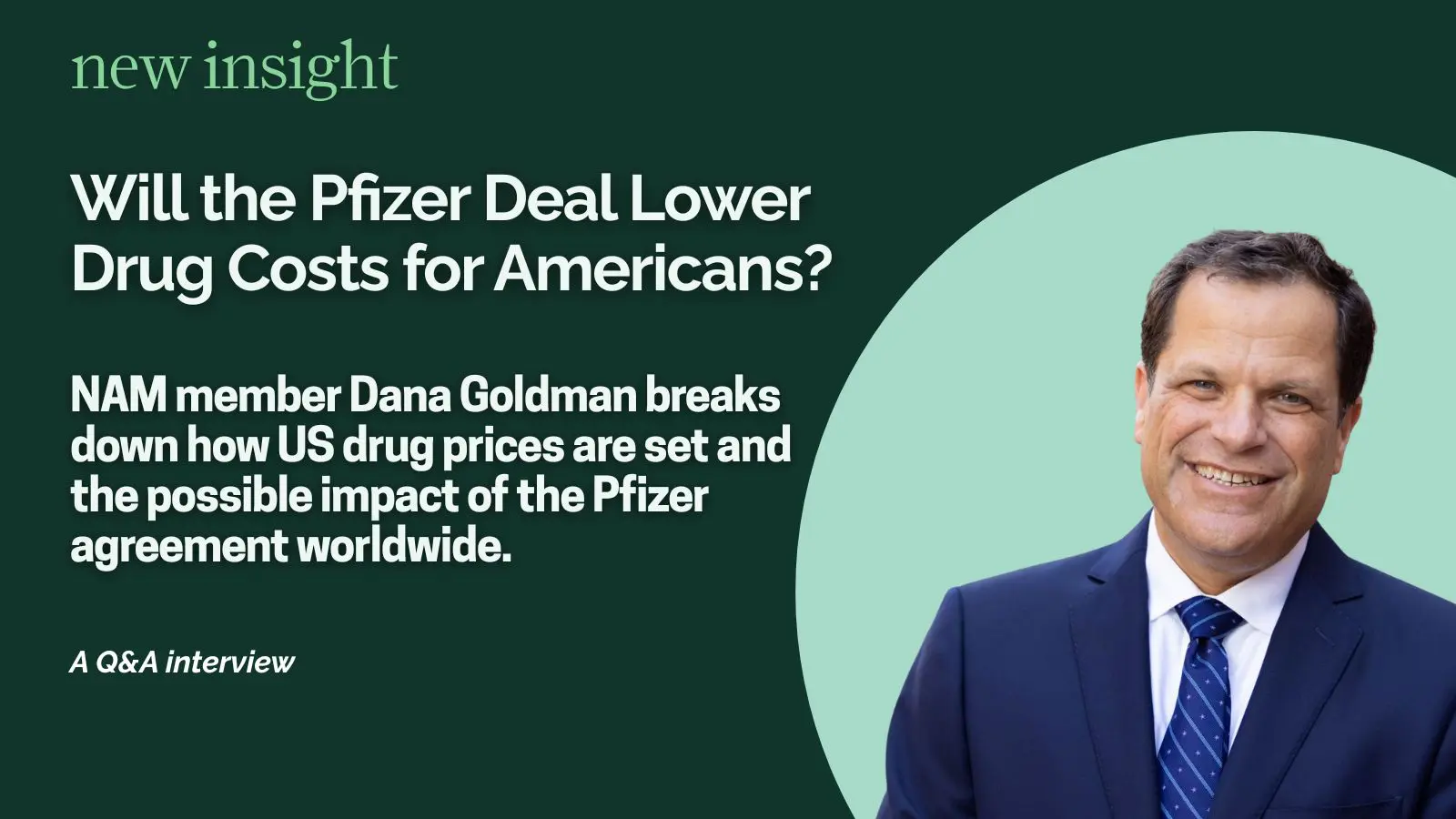NAM member Dana Goldman breaks down how US drug prices are set and the possible impact of the Pfizer agreement worldwide.
On September 30, 2025, the Trump administration announced that it had reached an agreement with Pfizer to lower its drug prices through a new direct-to-consumer platform. The administration presented the deal as part of a larger effort to prevent high US drug prices from being used to subsidize global innovation.
To better understand the Pfizer deal, we spoke with Dana Goldman, an NAM member and Founding Director of the University of Southern California Schaeffer Institute for Public Policy and Government Service. In the following interview, Goldman discusses how US drug prices are typically set, how the new agreement is likely to affect prices in the United States and Europe, and the need for more action to achieve greater price transparency and value for American consumers.
This interview has been edited for length and clarity.
Can you explain in simple terms how drug prices are typically determined in the United States?
Goldman: There is no simple answer in drug pricing because the process is both highly regulated and lacking any transparency.
Uniquely in the United States, we maintain a patchwork of public and private programs and entities negotiating with drug companies. These include Medicaid, Medicare, Medicare Part D, the 340B Drug Pricing Program, and Veterans Health Administration plans—and I haven’t even gotten to the commercial health insurers, who cover 180 million people in this county. The bottom line is we have a milieu of drug coverage programs, each with their own regulations and approaches.
Every drug has a list price that sometimes get measured, but this is not what the insurers pay on the consumer’s behalf. The actual drug prices are often negotiated confidentially by Pharmacy Benefit Managers, or PBMs, on behalf of beneficiaries. It’s an opaque system, although some are becoming more transparent.
PBMs leverage the fact that they are negotiating on behalf of sometimes millions of beneficiaries. The government sometimes demands similar deals, but these are hidden behind a wall of rebates and combined across products. So, the list price of a drug, even though it often gets quoted or cited in research, sometimes actually bears no relation to what most people are paying. The net price for brand drugs after accounting for rebates can be 50 percent or more below the list price.
Consumers do benefit from these negotiated savings, even if they don’t see them. Rebates help lower insurance premiums for their drug coverage, but these premiums are often partially or fully paid by an employer or the government. The problem is there’s a lot of opacity on the part of PBMs about what the rebates are, as well as additional fees they charge, and how much is being returned to plan sponsors. Congress has been concerned about this for a while.
Do Americans pay more for the same drugs than Europeans do?
Goldman: The first thing to note is that Americans do quite well in the generic market. Generics represent 90 percent of prescribed drugs, and generics are cheaper in the United States than other countries. So, 90 percent of our prescription market (by volume) is operating effectively. When you hear the occasional story about very expensive generics, it’s ironically because the prices went too low, all the suppliers exited the market, and then someone got a monopoly and raised the prices.
Now, when you look at the brand market, there is research that suggests we’re paying a lot more than people in other countries. But remember, you have to be very careful not to compare the list price—you have to look at the net price: the price after rebates and other adjustments.
But even the net price is higher in the United States than Europe, so the administration is exactly right when it says the United States is subsidizing drug discovery throughout the world. The reality is that we buy maybe 20 percent of all the pharmaceuticals in the world, but we represent 75 percent of the profits. Most of the profits are off the backs of American consumers, which are paid through a combination of premiums and out-of-pocket costs. This is for on-brand drugs, which are around 10 percent of the drugs prescribed.
How do US drug prices subsidize pharmaceutical innovation across the world?
Goldman: Pharmaceutical innovation will go where there’s a likelihood of substantial profits. Take a new obesity drug, for example. Obesity is a disease that affects many Americans. And that has rationalized manufacturers to invest in decades of research to develop a product that has enormous benefits for US public health. Cancer is another good example. For a long time, the Medicare program paid higher prices in the Part B program, but these prices subsidized new treatments (to which we also tend to get first access).
Once a drug is developed, however, Europe will negotiate prices as low as they can without regard to the cost of innovation. In this sense, it’s true that other countries are “free riding” on the United States when it comes to drug discovery because they aren’t paying the higher prices that encourage drug companies to innovate.
Our research has shown that a dollar of revenue in the United States stimulates far more innovation than a dollar of revenue in the European Union. And that’s because the United States is a profitable market. Europe isn’t making as much profit, so Europe’s calculus is not entering into the R&D decisions that are made by these companies.
The one thing that is clear is that other countries, especially the Europeans, have been free riding off the United States for a long time. So, if we could get them to pay higher prices, that is unambiguously good policy for America.
How is this new agreement likely to affect prices in Europe and America?
Goldman: I think there’s going to be enormous pressure for manufacturers to raise prices overseas, and we’ve already seen that in the case of obesity drugs. The problem is a lot of the rebates are hidden even in those countries, and so international list prices doesn’t mean anything anywhere—except when people are buying on their own, direct to consumer. That’s the only time a price actually has a market signal, and I believe those prices will go up in European countries.
I expect direct-to-consumer prices will go down in America, but it’s a question of who gets access to those prices. Most people are going through Medicaid or Medicare or through their commercial insurance plan. Direct-to-consumer is not how most people get their drugs in the United States or anywhere in the world. Furthermore, while TrumpRx is focused on the consumer, it may encourage direct contracting for drugs by employers, with potentially great benefit for those with commercial insurance.
Since high drug prices in America help to fund innovation, could lower prices slow down research and development?
Goldman: If we were to just import the European prices to the United States and apply them across the board, it would be devastating to future drug development. Absolutely devastating. There’s a lot of research that has shown that, including my own.
We have tolerated high prices in the United States because we’ve developed effective therapies to address previously intractable disease. Cancer, obesity, even Alzheimer’s—we’re making progress on all of that now. It would be devastating to that progress to just import the prices from Europe.
But you’ll notice that a lot of the recent federal drug pricing efforts apply just to the 340B program. Or just to Medicaid. They’re not going to affect Part D and they’re not going to affect the commercial market. So, the total impact is unclear.
What more could the United States do to improve drug price transparency and increase value for American consumers?
Goldman: My concern about the current policy environment is that there’s a very broad patchwork of regulatory policy and isolated interventions—like offering a website for consumers or doing something in the Medicare Part B program or negotiating lower prices on a few drugs. That tamps down a problem in one location but exacerbates irrational incentives in other locations.
In the case of the deal with Pfizer, we’re addressing one issue with one company in one market. If you think of the drug pricing ecosystem as a giant quilt of manufacturers and programs, we’re looking at one square on it and we’re only looking in the corner of that square.
I don’t think there is enough attention to the fundamental question that should matter for Americans: how should drug prices reflect the values held by Americans? And how can we make reimbursement decisions that get us closer to recognizing that value?
Most other countries have a health technology assessment process. Some countries do it well, and some just use it to renegotiate prices. America could lead here by saying, we need a system for figuring out the appropriate price for these drugs that takes into account American values; namely, that we want more innovation that is valuable to patients, including those with rare disease. I think there is a role for the National Institutes of Health or others to do a value assessment—not to tell drug companies what the price should be, but to generate estimates of what the value is.
GLP-1 drugs are the perfect example, because everyone believes they have tremendous value for weight loss and diabetes prevention, yet few are getting access to them through Medicare or commercial plans because insurers have no incentive to bear their upfront cost.
Commercial plans may look at someone who is obese at age 62 and say—that is Medicare’s problem in 5 years, so why should I invest in preventing diabetes?
But if we don’t cover them, we’re going to see only the more affluent getting access to them. Do we really want to live in a world where there’s a lot less diabetes among wealthy people but people who can’t afford medications end up getting diabetes and exacerbating already huge health disparities?
The other message is that we really need more transparency into what everyone is paying. This patchwork of hidden subsidies distorts behavior by patients, providers, and manufacturers—but especially PBMs. These intermediaries account for more than half of expenditures, but they are not the ones undertaking the risky R&D to bring new treatments to market. By passing sensible policy reforms, we can stop asking our sickest patients to bear the costs in hidden ways.


